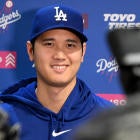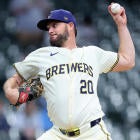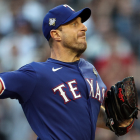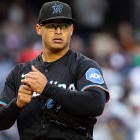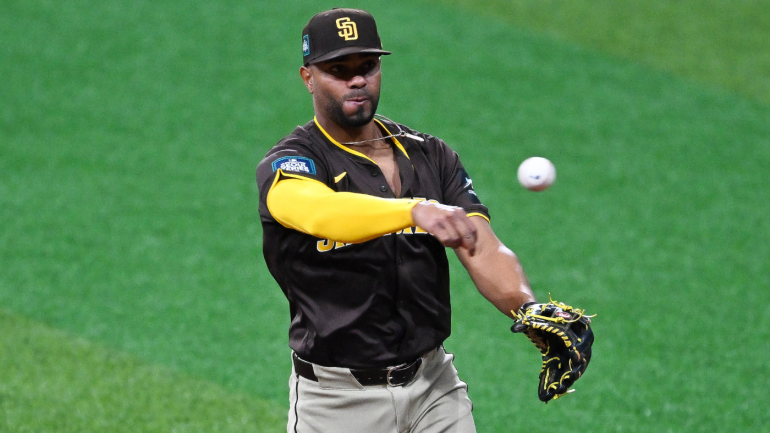
Major League Baseball had no way of knowing, when they scheduled the series last summer, that last week's season-opening series in Seoul, South Korea between the Los Angeles Dodgers and San Diego Padres would hold so much historical significance. Not only did the series give rise to the league's biggest story entering the year, the active investigation into Shohei Ohtani's former interpreter Ippei Mizuhara's alleged illegal gambling, it featured a number of notable debuts. Those began at the team and league level, of course, and extended all the way down to the positional level.
The headliner had Mookie Betts, primarily a right fielder to this point, embarking on his first season as a starting shortstop. The Dodgers had committed to playing Betts at the keystone early in the offseason, but plans changed during the exhibition season when Gavin Lux proved unfit to handle the six because of recurrent throwing issues. Betts is now, at 31 years old, attempting to man shortstop for the first time despite even now having fewer than 20 career big-league appearances at the position.
How well Betts takes to shortstop is one of the more pressing matters facing these Dodgers (albeit, perhaps, of lower priority than it was this time last week).
Rest assured that Betts won't be alone in attempting to fill a new or otherwise unfamiliar role. Below, CBS Sports has highlighted 10 other MLB players doing the same heading into 2024 and placed our predictions on if the change will succeed or not. Do note that the players are presented in alphabetical order.
1. Xander Bogaerts, 2B, San Diego Padres
The change: Moving from shortstop to second base.
Like Betts, Bogaerts is a former Boston Red Sox star attempting to switch sides of the second-base bag for a National League West team. The main difference between them is that Betts is moving up the defensive spectrum while Bogaerts is moving down it out of deference to Ha-Seong Kim. Bogaerts had never seen an inning at second base prior to the Seoul Series, having played exclusively on the left side of the infield. The Padres' defense should be improved with Bogaerts' relocation (Kim an is an elite defender), and it's not as though his bat is going to be stretched at another position. His 120 wRC+ last season would have ranked seventh among qualified MLB second basemen.
The verdict: It'll work.
2. José Caballero, SS, Tampa Bay Rays
The change: Serving as starting shortstop.
This time a year ago, Caballero was a 26-year-old career minor-league infielder whose biggest contribution to baseball history was his involvement in the Mike Leake trade. He's now slotted in as the starting shortstop on a 99-win squad. Life is a rich tapestry. Caballero has plenty of range to handle the six, though his arm is on the weaker side for the position. Our biggest question is about his bat. He was shockingly effective last season, posting a 90 OPS+ despite a poor exit velocity, an unceasing desire to pull the ball, and a sky-high pop-up rate (17.8%). The Rays have had success with unusual offensive profiles before -- see Isaac Paredes -- and Caballero is capable of pulling the ball hard enough to left that we could see him becoming fast friends with Tropicana Field's outfield cutout immortalized by Evan Longoria in 2011. All bets are off once Carson Williams, one of the game's top shortstop prospects, is deemed ready for action.
The verdict: It'll work defensively; we're still not sold offensively.
3. Henry Davis, C, Pittsburgh Pirates
The change: Serving as starting catcher.
Davis, the top selection in the 2021 draft, appeared in 49 games last season as part of his big-league debut. Although he was picked as a catcher, he caught just two innings at the big-league level. The Pirates would no doubt credit that statistic to the presence of Endy Rodríguez, another talented youngster who will miss the 2024 season after undergoing surgery to repair his UCL and a flexor tendon. We're not sure that's the entire story. Davis has a large frame that could work against him getting low-strike calls. It's possible that the Pirates also wanted to maximize his offensive capacity, as he has good raw strength and a feel for the zone. Even if he didn't produce much in the majors (78 OPS+) we feel more confident in his abilities at the plate than behind it.
The verdict: It'll work offensively; we're still not sold defensively.
4. Bowden Francis, RHP, Toronto Blue Jays
The change: Moving from the bullpen to the rotation.
Bowden Francis, Filth. pic.twitter.com/IVeVxJ9WDx
— Rob Friedman (@PitchingNinja) June 10, 2023
Francis, 27, has appeared in 21 big-league games to date, all as a reliever. He has plenty of starting experience in the minors, but generally pitchers who teams view as legitimate rotation candidates have received some exposure in that role by this point in their careers. Francis will try to prove that it's better late than never this spring using an arsenal that includes a low-to-mid-90s rising fastball, a pair of breaking balls, and a splitter. Pitch-modeling algorithms seem to like what he has to offer. We're willing to keep an open mind that he could be this year's Zack Littell -- that is, an older, completely unheralded right-hander who achieves surprising success in the rotation.
The verdict: It'll work better than expected.
5. Tyler Freeman, CF, Cleveland Guardians
The change: Moving from the infield to center field.
The Guardians reassigned former Gold Glove Award winner Myles Straw to Triple-A after he cleared waivers, setting up Freeman to be their Opening Day center fielder. He's an above-average runner who didn't have the arm for shortstop and isn't going to take over at second or third base for as long as Andrés Giménez and José Ramírez were under Cleveland's employ. It's now up to Freeman's bat to atone for any growing pains he encounters on the grass. He has a penchant for making contact and for hitting the ball on a line; walking and slugging has never been part of his game, however, meaning he's going to have to hit for average to make it work.
The verdict: It'll work if he hits.
6. Sal Frelick, 3B, Milwaukee Brewers
The change: Moving from the outfield to third base.
We must admit, we were surprised to hear Frelick was taking grounders at third base. We noted during his draft year that scouts expected him to see action at second base; he didn't, but he still went in the middle of the first round. He's since reached the majors on the strength of his bat-to-ball skills, wheels, and outfield defense. Along the way, Frelick has shown a much better arm than he had at Boston College -- per Statcast, his 90.8 mph average was right in line with the right-field average. We'd like to see more of Frelick's hands and reactions at the hot corner before we buy in fully, but the Brewers don't have a ton of good options there so the bar is only so high.
The verdict: It'll work if he hits.
7. Jordan Hicks, RHP, San Francisco Giants
The change: Moving from the bullpen to the rotation.
4 More Ks for Jordan Hicks.
— Rob Friedman (@PitchingNinja) March 9, 2024
6Ks thru 3. pic.twitter.com/ixy3IK2Wr9
We wrote in January about why the Giants were giving Hicks a look as a starter. The short version is that he has premium stuff, including a newly minted sweeper; improved control; and the benefit of joining a team that has shown a willingness to divert from traditional roles. We could see Hicks having success in a hybrid role of sorts that sees him turn over a lineup once or twice, depending on how he's throwing that given night. Anything beyond that seems unlikely to take, in our opinion. We'd love to be wrong, though, because unusual career arcs are one of the best parts of baseball.
The verdict: It won't work in a traditional starter role.
8. Reynaldo López, RHP, Atlanta Braves
The change: Moving from the bullpen to the rotation.
We took some liberties including López since starting isn't exactly a new thing for him overall. He has nearly 100 big-league starts to his name; he just hasn't started much lately, recording one over the last two years. What good is having the creative license if you're not going to abuse it from time to time? Anyway, López has premium stuff, including an upper-90s fastball and a nasty slider. The Braves' front office is one of the best at identifying pitchers they can extract greater value from. We believe they have a plan in place with López that includes limiting his exposure. Provided that proves to be the case, we think he has a chance to be a solid contributor at the back of their rotation.
The verdict: It'll work well enough.
9. Jackson Merrill, CF, San Diego Padres
The change: Moving from shortstop to center field.
We ranked Merrill as the 12th best prospect in baseball entering the spring, based largely on the strength of his shortstop defense and his contact chops. He's since slid to center field as a way to slot into the lineup without disrupting a loaded infield depth chart. Merrill has the athleticism to make it work, and he looked fine in admittedly limited opportunities during the Seoul Series. Ultimately, Merrill doesn't have to be a natural in center field to represent an upgrade over San Diego's other options.
The verdict: It'll work well enough.
10. A.J. Puk, LHP, Miami Marlins
The change: Moving from the bullpen to the rotation.
AJ Puk's 3Ks in the 9th pic.twitter.com/9Bzr3q3mjw
— Rob Friedman (@PitchingNinja) June 8, 2023
Once upon a time, Puk was a top-10 pick based on his Diet Chris Sale potential. Seven-plus years later, he's yet to start a big-league game. Blame it on an onslaught of injuries that have limited him to fewer than 150 major-league innings. The Marlins are giving Puk another chance to make good on his rotation dreams. He certainly has the arsenal for it, including a mid-to-upper-90s heater and a swing-and-miss sweeper. Will his body hold up long enough for him to solidify himself as a real starter? We hope so, but we'd be lying if we were optimistic based on his injury history.
The verdict: It'll work stuff-wise; health-wise? Who knows.
















